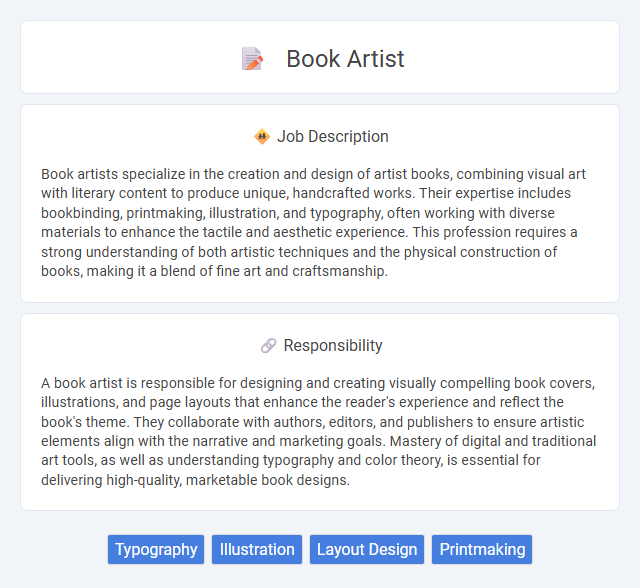
Book artists specialize in the creation and design of artist books, combining visual art with literary content to produce unique, handcrafted works. Their expertise includes bookbinding, printmaking, illustration, and typography, often working with diverse materials to enhance the tactile and aesthetic experience. This profession requires a strong understanding of both artistic techniques and the physical construction of books, making it a blend of fine art and craftsmanship.
People with a strong passion for creativity and attention to detail will likely find the book artist job suitable and rewarding. Those who prefer structured routines or minimal artistic expression may experience challenges adapting to the dynamic and visually driven nature of this role. Individuals who enjoy working independently and have patience for intricate design processes have a higher probability of thriving in this career.
Qualification
A book artist requires expertise in fine arts, graphic design, and printmaking, often demonstrated by a degree in fine arts or a related field. Proficiency in various artistic techniques, including illustration, typography, and bookbinding, is essential for creating visually compelling and structurally sound works. Strong creativity, attention to detail, and experience with digital design software further enhance a book artist's ability to produce unique, high-quality pieces.
Responsibility
A book artist is responsible for designing and creating visually compelling book covers, illustrations, and page layouts that enhance the reader's experience and reflect the book's theme. They collaborate with authors, editors, and publishers to ensure artistic elements align with the narrative and marketing goals. Mastery of digital and traditional art tools, as well as understanding typography and color theory, is essential for delivering high-quality, marketable book designs.
Benefit
A book artist likely benefits from a unique blend of creative expression and craftsmanship, which can lead to personal fulfillment and a distinctive portfolio. The ability to work with diverse materials and techniques may increase their marketability and open doors to niche art markets. Opportunities for collaboration with publishers or exhibitions could further enhance their professional reputation and income potential.
Challenge
A book artist likely faces challenges in balancing creative vision with the practical limitations of materials and production processes. Navigating the demands of publishers and clients may add complexity to maintaining artistic integrity. Meeting tight deadlines while ensuring high-quality craftsmanship probably tests time management and problem-solving skills.
Career Advancement
Book artists enhance their career advancement by mastering diverse techniques such as illustration, calligraphy, and bookbinding, increasing their marketability in niche arts and literary communities. Building a robust portfolio and networking with publishers, galleries, and literary festivals opens opportunities for commissions, exhibitions, and collaborations. Pursuing advanced education and specialized workshops sharpens skills, ensuring ongoing innovation and relevance in the evolving field of book arts.
Key Terms
Typography
A book artist specializing in typography meticulously crafts the visual appearance of text to enhance readability and aesthetic appeal within printed works. Expertise in font selection, spacing, and layout design ensures that each page communicates the narrative effectively while maintaining artistic integrity. Mastery of digital typesetting tools and a deep understanding of typographic principles are essential for creating harmonious and engaging book designs.
Illustration
Book artists specializing in illustration create visual narratives that enhance storytelling and engage readers across genres. They utilize skills in drawing, digital art, and mixed media to produce cover designs, chapter headings, and detailed scenes that complement the text. Mastery in software like Adobe Illustrator and Photoshop, combined with a strong understanding of composition and color theory, is essential for delivering compelling book illustrations.
Layout Design
Book artists specializing in layout design create visually compelling and readable page arrangements that enhance the overall storytelling experience. They expertly balance typography, imagery, and white space to guide the reader's eye and maintain consistent flow throughout the book. Mastery of software like Adobe InDesign and knowledge of printing processes are essential skills in producing professional, print-ready layouts.
Printmaking
Book artists specializing in printmaking create unique, handcrafted books integrating artistic prints such as linocuts, etchings, and screenprints to enhance visual storytelling. They master various print techniques to produce limited edition art books, combining typography, illustration, and textured paper to elevate the tactile and aesthetic experience. Their work often involves collaboration with writers, publishers, and galleries to exhibit and distribute these collectible pieces in art book fairs and specialty bookstores.
 kuljobs.com
kuljobs.com